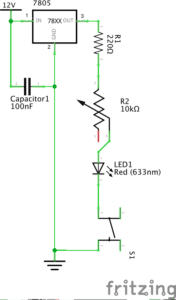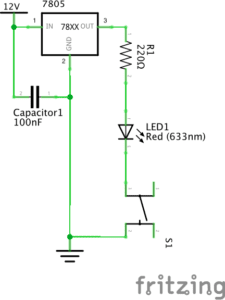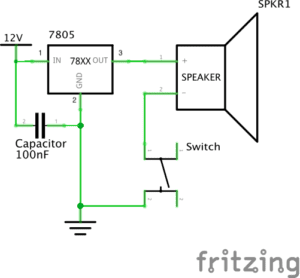


Recitation 1
Circuit 1: Doorbell
This circuit consisted of multiple elements, starting with a 12 volt power source at the beginning. Without this component, the circuit would have no power. The next component is a voltage regulator and its job is to maintain a consistent voltage level. There is also a capacitor that decreases the power level. The charges coming out of the capacitor and the second output of the regulator both get grounded, while the charge coming out of the third outlet goes directly to a speaker that makes noise and a switch that allows you to control whether noise comes out of the speaker or not. The purpose of this circuit is to emit noise out of a speaker. During the process of building the speaker we ran into a number of challenges that centered around our voltage capacitors being inefficient. We had to exchange three capacitors until our circuit was working properly.
Circuit 2: Lamp
Our second circuit and its purpose was to light a small LED light. It began with a 12 volt power source that entered into a voltage regulator that maintained a distinct voltage level, as well as a capacitor that lessened the power in the circuit.The charges coming from the capacitor and the second outlet of the regulator both get grounded, while the outward charge from the regulator travels through a resistor. This resistor does exactly what it is entitled and resists the current coming through it. Then the charge travels through the LED light that is supposed to light up and then goes through a switch that allows you to control the light manually.
Circuit 3: Dimmable Lamp
The third circuit we were required to built had to light up another LED light, but had to have the ability to turn a knob and dim the light. It began with a 12 volt power source that entered into a voltage regulator that maintained a distinct voltage level, as well as a capacitor that lessened the power in the circuit.The charges coming from the capacitor and the second outlet of the regulator both get grounded, while the outward charge from the regulator travels through a resistor. This resistor does exactly what it is entitled and resists the current coming through it. The charge then goes through a variable resistor that allows you to manually change the amount of resistance to the current before it enters the LED light and a switch.
Question 1: In a way, our circuits include interactivity because the different components in them communicate with one another. I believe they do this through the energy/ charge itself traveling through the circuit. It seems as though each component decides to either alter the charge or is altered by the charge before it is grounded. I also think the circuits are interactive in that they all have switches that we can interact with.
Question 2: I think that both Interactive Design and Physical Computing can be used to create Interactive Art in that the technology used can involve an audience. One of the examples that Zack Lieberman mentions is the “open mouth phenomenon”, where he feels that it is the pathway to someone’s heart. This can be influenced by Interactive Art that is created from Interactive Design and Physical Computing, an example being the car/ driver project that Lieberman works on. These projects involve a lot of research behind them in order to be constructed and many people do not realize that.